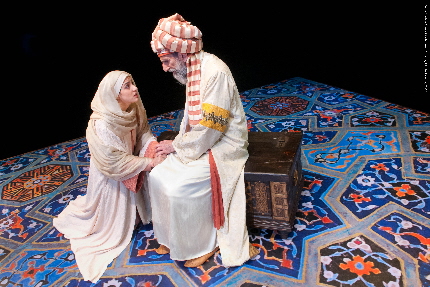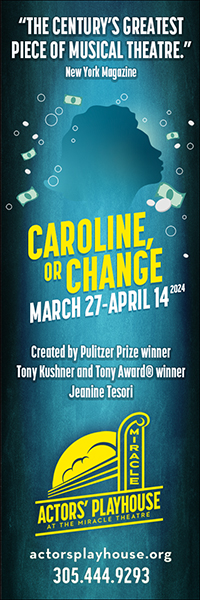 By Bill Hirschman
By Bill Hirschman
Even though Miami Theater Center wants its “children’s shows” to be enjoyed by all generations of patrons, its world premiere Everyone Drinks The Same Water is likely to be most appreciated by middle schoolers.
As always, the production is visually and aurally splendid as it evokes 13th Century Spain. But its sobering subject matter about cultural tolerance seems a bit too sophisticated for the elementary school kids whom MTC often performs for and too simplistic for the high schoolers and adults they frequently host.
Still, depicting the uneasy but mutually beneficial comity among Christians, Jews and Muslims in medieval Cordoba delivers a trenchant message of cooperation within a multi-cultural society that should land solidly with South Florida students in middle schools.
This work, written by MTC co-founder/director Stephanie Ansin and frequent collaborator, the designer Fernando Calzadilla, is lovely to look at with gorgeous costumes and set pieces depicting an exotic time and place.
But it’s much simpler, less action-oriented, less kinetic, less sensory-stimulating and comparatively sedate compared to their earlier works like last season’s quest fable The Red Thread which delighted crowds from elementary school children to their great-grandparents.
The story, rooted somewhat in historical events, occurs just after the Christian king of Castille and Leon has run off the Muslim ruler of the culturally sophisticated and wealthy city-state of Cordoba after 500 years of Arab rule. With a significant Jewish population living there as well, it marked the first time all three faiths lived together in relative harmony on Western soil.
But almost immediately the king becomes seriously ill after a drink of water, leaving his mother (Barbara Sloan) running the region; her first item on her to-do list is to turn the Grand Mosque into a Christian cathedral.
When many people in the city also sicken after drinking the water, the three factions accuse each other of plotting to destroy one another – a theme that Ansin and Calzadilla mean to resonate with our 21st Century prejudices and suspicions.
Three teenagers – a Christian prince (Troy Davison), a Jewish doctor’s strong-willed daughter (Yevgeniya Kats) and a Muslim judge’s highly-intelligent daughter (Diana Garle) — join forces to find the source of the poison and save the town. Along the way, they restore the separate peace that allowed Cordoba to be one of the most socially, economically, artistically and intellectually advanced communities long before the Renaissance.
Thematically, the most intriguing and faithful element of the script is that while the community comes together at the end, the walls are not torn down. They join in a ceremony celebrating the return of pure water, but no one’s singing Kumbaya. They are not neighbors who will share a bottle of wine at the end of the day; they are neighbors who recognize each has something that will benefit each other.
The acting, as always, is remarkably committed to the material with not a shred of condescension to the young audiences, although the simplicity of the dialogue and vocabulary is aimed at the middle schoolers. Other cast members include Steve Gladstone, Howard Elfman, Jessica Farr and Joshua Jean-Baptiste.
Ansin’s staging is once again straight-forward and sure although the pacing of this one – with its reliance on talking rather than action – seems a bit pokier and more deliberate. But there are outstanding moments. In one, bells, music and a muezzin’s call prompt members of the three faiths to simultaneously pay homage to their individual God in their own way, all sharing a devout acknowledgement of a Deity.
What Ansin, Calzadilla and their team triumph at is stagecraft that creates a stylized but evocative world, although this time the visuals are sparer than in their other productions. The most obvious element is a large mosaic-tiled floor canted toward the audience that serves as the primary playing area. In the second half of the play, the floor rotates to represent other locations. It is accentuated with simple pieces such an ornate chest for characters to sit upon and a large decorative metal lamp hanging nearby.
The costumes deserve note, especially the Queen’s ebony Sunday-go-to-meeting dress with a large cross. It is remarkable for a tall black headdress that tops off with a hoop perhaps a yard in diameter and then drops folds of gauzy black veil down to her waist.
Perhaps the most impressive element is the sophisticated soundscape and original musical score by Luciano Stazzone. He and a team of musicians create a vibrant, lush and exotic background for the entire show. The digitized sound contains dozens of sound effects and copious underscoring that combines instruments native to all three cultures, from the shofar to the dumbek. MTC productions usually are not considered for Carbonell nominations but this effort provides some of the most imaginative sound design we’ve heard regionally in some time.
Otherwise, adults will probably long for something meatier than Rodney King’s “Can’t we all get along?” but children, brought in from school to what is often their first theatrical experience, will have a lot of chew over on the bus ride back to class.
Everybody Drinks The Same Water runs through June 1 at Miami Theater Center at 9806 NE 2nd Avenue in Miami Shores. Performances 7 p.m. Saturday, 2 p.m. Sunday, 10:30 a.m. Tuesday and Thursday; 10 a.m. Wednesday and Friday. Running time about 70 minutes. For more information, call (305) 751-9550 or visit www.mtcmiami.org.
To read a feature story about the production, click here.








 A PaperStreet Web Design
A PaperStreet Web Design
